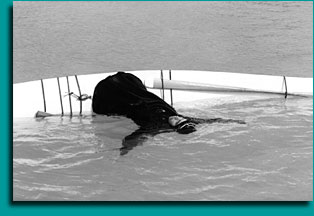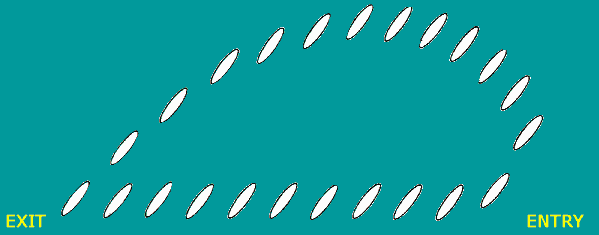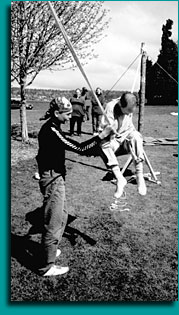 In Greenlandic, the word ‘maligiaq’ means “medium-sized wave.”
In Greenlandic, the word ‘maligiaq’ means “medium-sized wave.”
A seventeen-year old Greenlander with that name has made some very large waves in the kayaking world in the past two years.
Maligiaq Johnsen Padilla (pronounced muh-LIG-ee-ahk YOON-sen pa-DEE-uh) came to the U.S. for a year in September of 1998 to visit his father, Augusto “Geno” Padilla, in Colorado, and to improve his English.
Maligiaq was only 13 during the 1995 National Kayaking Championship meet, yet he won every event in his age group. In 1998, he became the Champion Kayaker of Greenland. At the age of 16, he had defeated all kayakers, even the best of the 20- to 34-year age group—the age group that usually produces the national champion—becoming the youngest Greenland kayaking champion ever.
Maligiaq’s heritage is deeply rooted in kayaking. His mother’s ancestors were from Vester Eyland, a small island near the mouth of Disko Bay that is noted for kayakers of exceptional skill. Living on a small island forces subsistence hunters to go out almost every day in all kinds of weather, or they face starvation. Kayak hunters either become skillful or die trying.
Yet, no matter how skillful a kayaking seal catcher becomes, hunting large sea mammals from a kayak is a dangerous occupation. Maligiaq’s great-grandfather lost his life in 1929 when a seal he had harpooned dragged him and his kayak so forcefully that his back was broken.
Maligiaq’s grandfather, Peter Johnsen, now 73, is a retired seal catcher. When Maligiaq was a small boy, he was riding in a rowboat with his grandfather when his grandfather’s gun accidentally discharged.
With his hand badly injured, Peter was unable to row the boat. Even though he was only four years old, Maligiaq managed to row the boat to shore. Maligiaq’s father says that ever since that incident, Maligiaq and Peter Johnsen have been “as close as two coats of paint.”
Over the years, Peter taught Maligiaq several special kayaking skills that he has added to those he learned in the Greenland National Kayak Association’s training program.
When Maligiaq came to the States, he brought a sealskin-covered kayak with him. Unfortunately, it was damaged in shipment.
One gunwale was badly cracked about a meter back from the bow, which caused the bow to hook to one side. Although Maligiaq performed in the damaged kayak at the 1998 Delmarva Paddler’s Retreat in Maryland and the Southwest Canoe Rendezvous in Huntsville, Texas, it tended to go in a circle when he paddled it upside-down.
To prevent further damage to the kayak, Maligiaq decided to build and use another kayak during his stay.
He built the new kayak in my garage in Houston. Several of his American friends donated the materials he needed and his new kayak quickly took shape. As he worked on the kayak, he listened to Danish rock music on his CD player.
In the two months my wife Jessie and I had Maligiaq as our house guest, members of the Houston Canoe Club took him kayaking, parents wanted him to meet their teenage sons and daughters, and he went cycling with Olympic hopefuls at a local velodrome.
The Honorary Vice Consul of Denmark took him jogging in a Houston park to explain to him in Danish the dangers and problems of exercising in the heat and humidity of the Houston area. Early in his stay it was not always possible to tell if he understood what we were saying to him in English.
During Maligiaq’s stay, I donated a rare 1904 Point Hope kayak that had been hanging in my workshop since 1958 to the Inupiat Heritage Center in Barrow, Alaska. When I mentioned Maligiaq’s visit, the center made arrangements for him to travel to Barrow to demonstrate Greenlandic rope gymnastics and kayak rolling at a large native celebration.
Maligiaq arrived in Barrow in February. Since the sea was frozen, Maligiaq borrowed a plastic kayak and demonstrated rolling in an indoor pool. His biggest thrill while in Barrow was to find native food that was like that at home.
He had been away from Greenland for four months, and he missed Greenlandic food. In the lower 48 states, he ate a lot of beef jerky, but it tasted quite different from dried seal meat. He brought a large supply of dried seal meat with him back to Colorado.
In the spring of 1999, Maligiaq traveled to Texas. Mark and Jennifer White, of Austin, wanted him to help them build Greenland kayak replicas at their home. Maligiaq covered his own kayak framework at their home, to show them the procedure.
Instead of sealskin, he covered his kayak with nylon fabric and a white Hypalon coating. He had to substitute cowhide for the bearded sealskin deck-strap line normally used; we found some narrow horse reins at a Houston saddle store that worked quite well. He completed his new kayak just in time for the 1999 symposium season.
Maligiaq often demonstrated his forward stroke at the kayaking events. Instead of holding the blade perpendicular to the water, he paddles with the top edge of his paddle blade tipped forward.
George Gronseth observed the same style of paddling at a training camp in South Greenland in 1990: “…Greenland paddle is held with the top edge tipped slightly forward”.

I have seen many paddlers in Greenland who appear to hold their paddles with the blade more or less at a right angle to the surface of the water. Maligiaq calls this a “beginner’s” way of paddling. His grandfather taught him a stroke that he had used as a seal catcher on Vester Eyland. This stroke is done with the top edge of the paddle tipped forward about 40 degrees from vertical, according to Maligiaq.
The angle is held more or less throughout the stroke, including the return phase. The drawing above illustrates how the paddler would see the stroke if looking downward and to one side as he or she paddles.
The path followed by each blade for each stroke is somewhat teardrop shaped, except that the working part of the stroke appears to be more or less straight, as seen by the person doing the paddling. During the return part of the stroke, the blade moves forward as it is lifted out of the water, then it curves downward again as it goes into the water.
Some Americans who use Greenland-style paddles are skeptical of any stroke that does not position the blade face at right angles to the surface of the water.
Most of my use of Greenland-style paddles was in the ‘50s and ‘60s, and I don’t recall ever worrying about it. It was simply a matter of paddling in whatever seemed the most natural and comfortable way. However, when Greg Stamer, an enthusiast of Greenland kayaking from Orlando, Florida, used the “beginner’s” stroke while paddling alongside Maligiaq, Maligiaq was using the stroke his grandfather taught him, Maligiaq easily pulled ahead of Greg.
Greg felt that he tired more quickly than Maligiaq, even after making allowance for the fact that Maligiaq was younger and had trained harder. That made a convert out of Greg.
There might be a theoretical advantage in using a narrow-bladed paddle with the blades held tipped forward. A narrow-bladed paddle tends to flutter more than a wide-bladed one, especially when accelerating.
This is because of vortex shedding, which is more noticeable when one uses a narrow paddle. This phenomenon was discussed in my article entitled “The Narrow Blade,” When a narrow paddle enters the water with the working faces at right angles, the water tends to flow equally around each edge. It makes a vortex that looks like a miniature tornado, along each edge. The axis of each vortex is parallel to the edge.
However, if the top edge of the paddle blade is tipped forward throughout the stroke, the vortex will shed toward one edge all of the time. It becomes predictable, instead of alternating, and the paddler can compensate for and control it. This might be an important factor in the effectiveness of this paddle stroke.
To Greenlanders, the most important advantage of this stroke is that it makes it easier for the working blade to slip out of the water at the end of a stroke. The blade will climb out of a wave while the paddler maintains his form and cadence.
Several other Greenlanders have confirmed the advantages of this paddle stroke. All of them emphasized that they used this stroke to help free the blade as it started forward on the return phase.
Maligiaq used this stroke while racing against professional kayak racers in Montreal “World Championship” races in 1999. Using a Greenland paddle and a borrowed touring kayak with no rudder, he competed against kayakers who used racing kayaks and wing paddles. He made a respectable showing in the top ten, in spite of having to paddle a lot on one side to compensate for side winds.
Maligiaq demonstrated an ancient Inuit game during his U.S. kayaking exhibitions. While rope gymnastics are known in other parts of the Arctic, they are an important part of the annual kayaking championships in Greenland. Contestants perform as many of the 74 rope maneuvers as possible during 30 minutes.
Points are awarded for style and for the number of maneuvers performed. Maligiaq did 25 maneuvers in 30 minutes, and he did all of them well enough to win this category in the championship.
The rope exercises not only strengthen paddlers, they develop balance and train the paddlers to maneuver their bodies in the same way they would when rolling a kayak.
To build a rope gymnastics set-up, install three strong eight-foot-tall (2.4 meters) posts. The poles should be arranged in a straight line with two of them about six paces apart and the third about three paces beyond one end. You’ll need about 50 feet of 1/2-inch (12 cm) rope.
Fasten two lengths of rope securely about six feet (180 cm) from the ground to each of the poles that are farther apart. The ropes should hang side by side, and sag to about four feet (120 cm) off the ground midway between the poles. You’ll need around 50 feet (15 meters) of rope.
A shorter, single rope should be tied about seven feet (210 cm) above the ground between the poles that are three paces apart. This rope should be stretched so that it is taut, with almost no sag.
The spinning gymnastics performed on these ropes can help teach rolling control. For the starting position for the rope event, sit with your behind between the sagging side-by-side ropes, with your lower legs hanging over the ropes.
Your feet should cross each other to lock yourself in place. Grip both ropes firmly with each hand; one hand should be in front of you and the other behind. The hand grips and the locked legs will help keep your behind wedged between the ropes throughout the maneuvers.
The basic maneuver is to spin completely around by shifting your weight to “capsize” and then righting yourself, in one continuous motion. For a more complex maneuver, place a hat on the ground and pause while upside down, then reach down, pick up the hat, put it on, and roll back up. (This means that you must let go with one hand while upside down.)
Gripping the single rope will cut into your fingers; it can be very painful. In Greenland, single-rope gymnastics help toughen a kayaker for the rigorous life of a seal catcher.
Maneuvers performed on the single rope are all done in the hanging position, with the objective of raising your body to wriggle over the rope in various ways. The basic maneuver begins by hanging, with your hands facing opposite directions. Move the elbow on your hand facing forward up and over the rope; with the other hand, pull yourself over the top of the rope and slip over it to finish.
All of the rope maneuvers are difficult to perform. In one exercise, Maligiaq sits sideways on the double ropes with both feet hanging on one side. Then, without touching the ropes with his hands, he kicks one leg at a time over the rope, and turns completely around horizontally, returning to the starting position.
Maligiaq finished his year in the U.S. by paddling around the Statue of Liberty with some New York paddlers. In his wake, he left many paddlers inspired by his talent and knowledge of Greenland kayaking.
I, for one, was sad to see him go. So was the guy at the convenience store down the road where Maligiaq bought beef jerky.

